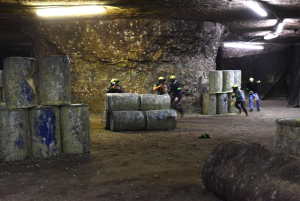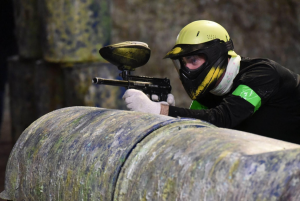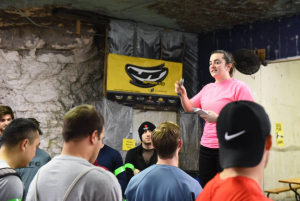Anastasia Ambrosio, OMS III
ACOEP RSO Student Conference Chair
Kansas City University of Medicine and Biosciences
 The nurses, the PAs, and even a stray patient in the hallway stared at me, all alarmed. I was excited to get a pimping question right. Muffled heart sounds, hypotension and JVD: the triad for cardiac tamponade. I suppose I did not have to scream “Beck’s Triad” in the middle of a packed ER. However, the last time I was answering that question, I was in a different environment; one with shots ringing in my ears, people yelling, and everyone covered in paint. This is a story about how the KCU Emergency Medicine club e-board pulled off “Medical Paintball,” and how it has helped me throughout rotations.
The nurses, the PAs, and even a stray patient in the hallway stared at me, all alarmed. I was excited to get a pimping question right. Muffled heart sounds, hypotension and JVD: the triad for cardiac tamponade. I suppose I did not have to scream “Beck’s Triad” in the middle of a packed ER. However, the last time I was answering that question, I was in a different environment; one with shots ringing in my ears, people yelling, and everyone covered in paint. This is a story about how the KCU Emergency Medicine club e-board pulled off “Medical Paintball,” and how it has helped me throughout rotations.
It took us an entire academic year to plan Medical Paintball. We wanted to create a game where each person had to medically triage and treat patients in a trauma situation. Our plan was to integrate the medicine into a paintball game of capture-the-flag. After we found a venue that could accommodate our plans, we created a schedule that included 2 sessions that lasted 2 hours each and involved 60 students per session. One game of medical paintball was capped at 30 minutes; each session played 4 games. After the logistics were laid, we focused on the rules of the game and how we were going to manage 120 students armed with paintball rifles in underground, dark caves.
medically triage and treat patients in a trauma situation. Our plan was to integrate the medicine into a paintball game of capture-the-flag. After we found a venue that could accommodate our plans, we created a schedule that included 2 sessions that lasted 2 hours each and involved 60 students per session. One game of medical paintball was capped at 30 minutes; each session played 4 games. After the logistics were laid, we focused on the rules of the game and how we were going to manage 120 students armed with paintball rifles in underground, dark caves.
 We held a mandatory meeting a few days before the event to go over rules and teach general trauma treatments. On game day, every student would be equipped with a randomized injury card, which indicated the injury he or she would suffer if shot in a particular body region. Injuries and treatments were planned out by the e-board and faculty members. During the meeting, the e-board taught students how to properly treat every injury they would see throughout the game. Each student would be playing capture-the-flag, and when he was shot, he became out of play. The other team members would then have to “rescue” him/her and walk back to the base together. At each respective base, each team had two moderators, either doctors, professors, or fellows. Depending on where on the body the student was shot, the rescuing student had to correctly treat the injury on the student’s injury card. If he or she answered correctly, a reward of a full paintball refill would be given. Incorrect answers resulted in no refills. Both students were then allowed to return to play.
We held a mandatory meeting a few days before the event to go over rules and teach general trauma treatments. On game day, every student would be equipped with a randomized injury card, which indicated the injury he or she would suffer if shot in a particular body region. Injuries and treatments were planned out by the e-board and faculty members. During the meeting, the e-board taught students how to properly treat every injury they would see throughout the game. Each student would be playing capture-the-flag, and when he was shot, he became out of play. The other team members would then have to “rescue” him/her and walk back to the base together. At each respective base, each team had two moderators, either doctors, professors, or fellows. Depending on where on the body the student was shot, the rescuing student had to correctly treat the injury on the student’s injury card. If he or she answered correctly, a reward of a full paintball refill would be given. Incorrect answers resulted in no refills. Both students were then allowed to return to play.
Game day went perfectly. Half of the e-board played in one session while the other half moderated the games to make sure all the rules were followed. It turned out to be one of the best and most fun days I have ever had in medical school. It prepared me not only for emergent treatments and trauma-related injuries, but also for rigorous pimping in a fast-paced environment.
Learning doesn’t always have to be in a classroom, and it can be fun. When I was falling to my knees after being shot in the back, I was thinking about what anatomical structures were threatened, and a few choice words I had for the person who shot me (Dr. Stephanie Davis). I started thinking on my feet like a clinician, which is not something a second-year medical student gets too much exposure to. I wish I had more experiences like this, and highly recommend any club or interest group seriously considering an event such as medical paintball. As an aside, I recommend do not invite professional hunters or ex-soldiers to participate.
